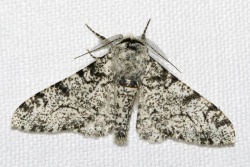
- Kingdom: Animalia
- Phylum: Arthropoda
- Class: Insecta
- Order: Lepidoptera
- Family: Geometridae
- Genus: Biston
- Species: B. betularia
Biston betularia
B. b. betularia
B. b. cognataria
B. b. parva
| Peppered moth |
|---|
 |
| Scientific Classification |
|
| Binomial Name |
Biston betularia |
| Subspecies |
B. b. betularia |
Peppered moths were thought to be one of the most clear evidences for biological evolution by illustrating how natural selection functions. Some peppered moths are light in color, others are darker. As tree trunks grew darker due to soot from air pollution, the white moths were thought to be more easily seen as they landed on the trunks and thus thought to be more easily caught by predators. This would illustrate how a change in environment can cause a change in the population ratio inside a species.
Photographs of the two kinds of moth in place on tree trunks were widely distributed to show the obvious visual difference between white and dark moths.
John Mackay cites an article by Jonathan Wells and points out that these moths almost never land on tree trunks during the day. Scientists that have tracked the behavior of the moths, rarely see these moths on tree trunks because they usually land on higher, smaller branches of the trees. The tree trunk seemed better in thought experiments because the lichen growing on the trunks would help camouflage the moth, but this is not true on the branches. Mackay notes "Whatever causes the change in ratio of light to dark peppered moths over time, it cannot be predation by birds seeking out the less camouflaged moths on tree trunks. Yet the story remains a centerpiece in evolutionary lore."[1](Mackay, 2000).
If the moths rarely land on tree trunks, where did all the pictures come from? According to Mackay, Wells found that the moths were sometimes glued to the trunk for pictures. They also were sometimes pinned to the trunks or placed on them, or were released close to the trees so they would land on the trunks.
Presumably the illustrators believed that the peppered moths frequently landed on the tree trunks, and so simply arranged the photographs to document what they thought was already shown experimentally. However this resulted in something that was widely published but did not have the needed experimental support.
Most creationists would accept the possibility of natural selection, but would question the mechanisms by which natural selection could help accumulate large genetic changes.
Between 2000 and 2006 the British biologist Michael Majerus studied the peppered moth in a large hectare splot near his house in Springfield, England, near Coton, Cambridgeshire. He carefully examined wild moths before starting and was able to determine that 36% of the moths really were found on the trunks of trees in daytime.[1] Moths generally don't move in daytime, and a dark moth on a light colored tree would stand out to a bird. He then planted moths carefully on special sleeves on branches of trees and counted those that disappeared in the first 4 hours of daylight.[2] He found that there was a definite difference in the number of moths that disappeared when color was taken into account. About 80% of the light colored moths survived and only about 70% of the darker moths survived, which would make a definite difference in the long term populations of each color. He also managed to observe birds actually eating the moths in a quarter of the more than 4,000 cases he studied.
|
||||||||||||||||||||